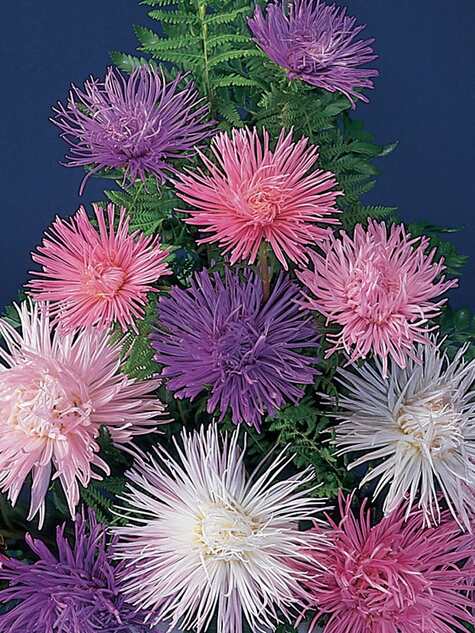
Aster Fireworks® from Burpee.com
I love to think of nature as an unlimited broadcasting station, through which God speaks to us every hour, if we will only tune in. ~George Washington Carver ~
Here come the Monarchs! We will soon be graced with these beautiful insects, as they make their return flight from the northern climates to their overwintering sites in the mountains of central Mexico. Their journey takes them through Texas, flying mostly over and to the east of the Balcones Fault, which includes most of Comal County. They will be fueling up for this flight by feeding on the many nectar plants in our area. To view their route, see the migration map at the end of this article.
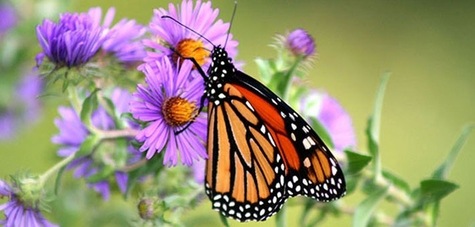
Monarch on New England Aster from Rick Hansen USFWS (US Fish and Wildlife)
- Nectar flowers for the Monarchs include blue mistflower and other asters, butterfly bush, goldenrod, antelope horns and other varieties of milkweed. Many of these are available as transplants at local flower outlets and food stores.
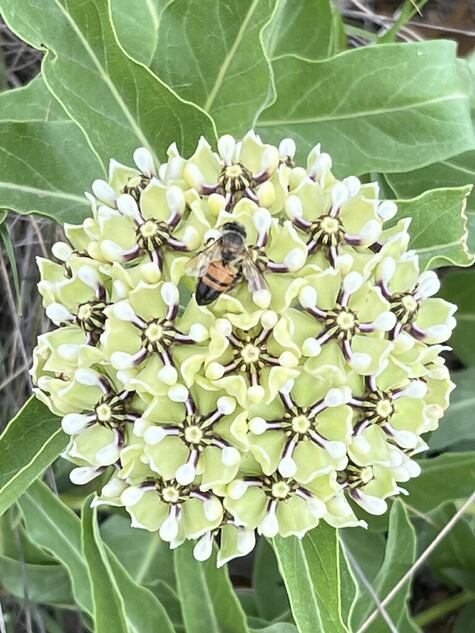
Antelope Horns Milkweed (Asclepias asperula) from CMG Adrienne
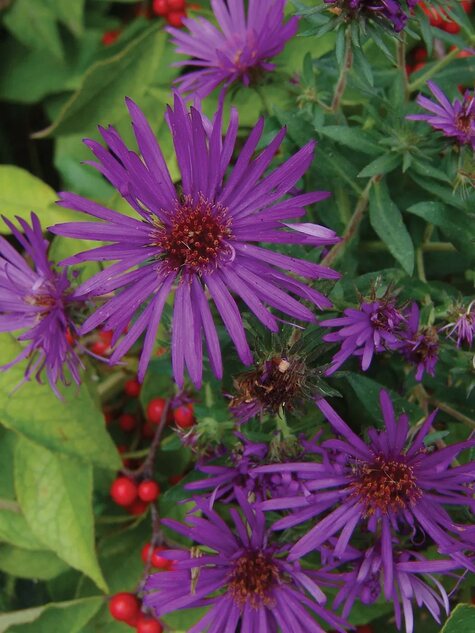
Aster Purple Dome® from Burpee.com
- Aster is a fall show stopper for edging gardens and filling containers. This small perennial plant has a clumping or mounding shape, growing from 18-to-24 inches, with a 3-foot spread; flowers are profuse in October and November. Native to the eastern states, Fall Asters are now widely adapted. They are nearly pest-free, and are winter hardy in Central Texas. These plants like well-drained soil, full sun to partial-shade, and an occasional watering. Their nectar is a magnet for butterflies and bees.
- Fall is the time to seed bluebonnets and other spring-flowering wildflowers, as they must have time to develop good root systems throughout our cooler months for blooming in spring. Sow seeds by raking and sprinkling them into a shallow layer of soil, then turn the rake over and cover them lightly; keep the soil moist until the seeds sprout. For more information read this informative article on planting wildflowers by Dr. Jerry Parsons.
- Divide and move spring-flowering plants that are in decline: daylily, liriope, iris, and other perennials. If there is more than you need, share this excess with friends and neighbors.
- Fall webworms can be a problem on pecan and other trees. Puncture the lower webs with a rake handle or a long stick of bamboo; birds and wasps will feed on the larvae. Higher webs may need to be sprayed with Bacillus thuringiensis (Bt).
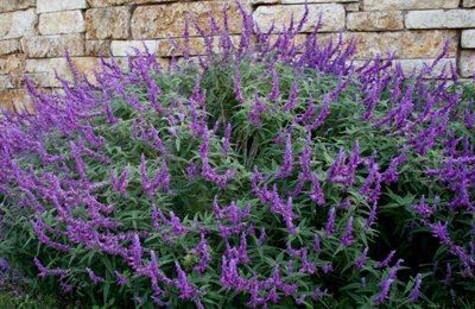
Mexican Bush Sage from CentralTexasGardener.org
- Mexican Bush Sage (Salvia leucantha) will add a large-scale touch of purple to the fall garden. Like other plants in the Salvia family, it is drought tolerant and highly pest-resistant. It blooms in the fall with eye-catching spikes of solid purple, or purple and white, that attracts butterflies and hummingbirds. The foliage is soft green with a silvery tint. This drought-tolerant herbaceous perennial is native to Mexico and Central America. It can grow to 4-feet high and wide, and needs full sun for the most blooms. After a winter freeze, cut it back and cover the stump with 4-inches of mulch. It should produce new growth in the spring. The flower stems are brittle, and need to be protected from high winds. Hardy to Zone 8.

Graceful Grasses® Vertigo from ProvenWinners.com
- Consider using a row of tall grasses as a living screen in your garden plans. Proven Winners offers Vertigo® purple fountain grass, a fast-growing, large annual grass, in its Graceful Grasses® series. Vertigo, with its purple-black color and upright stature, will provide privacy around an outdoor seating area when planted in a row, or perhaps obscure a view of the street or something unsightly. It will provide an architectural element when planted alone. This heat-tolerant seasonal grass matures to 8-feet in height with a width of 3-feet, and loves sun to part-shade. For more permanent screening, try one of the annual fountain or switch grasses in the Prairie Winds® series.

Container Gardening on a Patio from BHG.com
- Fall is a great season to try something different for gardening in containers, as our long autumn season gives us time to enjoy being outdoors on a balcony or a patio. The addition of Pumpkins and Gourds will add to the seasonal colors; they are available now in area plant outlets and grocery stores, in many choices of colors, textures, and sizes. Proven Winners offers help with design, color, structure, foliage and texture.

Autumn Brilliance Fern from WilsonBrosGardens.com
- Ferns for the fall garden can give texture and color to shady areas, such as understory and edges of flower beds. The fronds of Autumn Fern (Dryopteris erythrosora), emerge a copper red color in the spring, mature to green for the summer, then return to rusty red in the fall. It is cold hardy, pest- and deer-resistant, and drought-tolerant. Other ferns that do well in the fall here are Holly fern, Sword fern, and Wood fern.
Vegetable Gardening Information from Texas A&M Horticulture:
Fall vegetable crops are categorized as long-term and short-term crops. The duration of these crops depends on the date of the first killing frost and the cold tolerance of the vegetables. Group the plants according to their frost tolerance. Plants killed by frost can be removed after being killed to open up garden space for the next planting.
- Long-term, frost-tolerant vegetables include beet, broccoli, Brussels sprouts, cabbage, carrot, cauliflower, chard, collard, garlic, kale, lettuce, mustard, onion, parsley, spinach, and turnip.
- Short-term, frost-susceptible vegetables include bean, cantaloupe, corn, cucumber, eggplant, okra, pea, peppers, Irish potato, sweet potato, and squash.
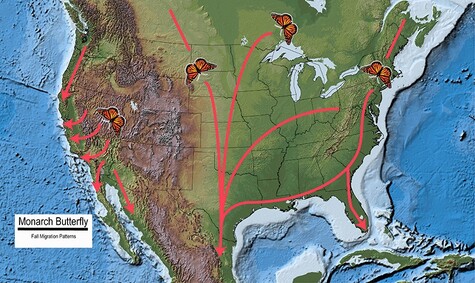
Migration Map for Monarch Butterflies from Monarchwatch.org
by CMG Adrienne M
Sources: these and other sites: TexasSuperstar.com; DavidsGardenSeeds.com; Aggie-Horticulture.tamu.edu; ProvenWinners.com; Burpee.com; BetterHomesandGardens.com; almostedenplants.com; txmg.org; CentralTexasGardener.org. Travis County AgriLife. Lady Bird Johnson Wildflower Center. North Carolina University Extension. U.S. Fish & Wildlife Service.